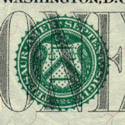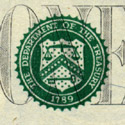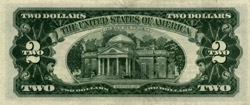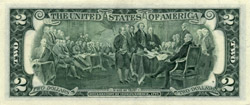

Those Series 1966 USNs may never have seen widespread use, but they did introduce significant changes, to both designs and printing methods, that would soon affect notes of all denominations and types. The printing change affected the signatures and series date: These features were once again engraved in the printing plates rather than overprinted along with the seals and serial numbers. The design change was the overhaul of the Treasury seal: Its elaborate detail was simplified, the shield in its design was given a squarer shape, and its inscription was changed from the old Latin "Thesaur. Amer. Septent. Sigil." (abbreviating "Thesauri Americae Septentrionalis Sigillum", which, oddly, translates as "The Seal of the Treasury of North America") to the simple English "The Department of the Treasury, 1789".


Engraved signatures returned to the FRNs beginning with Series 1963B. The changeover to the new Treasury seal came with the next series, and was enough to bring about a new series date of 1969 for these notes.
Also in 1969, the FRNs of $500 and higher were finally discontinued. None had actually been printed since the 1934 series, but only because the existing supplies had been adequate to meet demand. By 1969, the supply of these high-denomination notes had decreased to the point that a new printing would have been required, and the Treasury and Federal Reserve jointly decided that the usage of these denominations was so low that the production of a new series would not have been cost-effective. On July 14, 1969, the FRBs returned to the Treasury for destruction all of the $500, $1000, $5000, and $10,000 notes then in their vaults, and since that time they have not recirculated any of these notes that have come in through the banking system.
In 1971, the BEP began another changeover to newer printing technology; but this time, it was the overprinting process that was affected. The new Currency Overprinting and Processing Equipment, COPE for short, created a minor variation in the typeface of the serial numbers. For most of the next decade, until all of the old equipment had been replaced, both the old and new styles came off the presses. For more information, see the page on COPE vs. conventional serial numbering.


Finally, in 1976, the $2 denomination was reintroduced, as an FRN and a commemorative of the nation's bicentennial. It was given a new back design, depicting the signing of the Declaration of Independence; this was the third complete replacement of a small-size design, after the $1 back in 1935 and the $1 face in 1963. It had been hoped that the reissue of the $2 note would reduce the BEP's workload by decreasing the demand for $1's; but the public, having had no $2 notes for ten years (and very few of them for decades before that), had grown accustomed to using multiple $1's in transactions, and never really took to the $2 denomination again. Therefore, after a brief period of widespread but only occasional usage in mid-1976, the $2 FRN became something of a collectors' item--available at most banks, but rarely requested, and almost never issued except by request.
At any rate, with the redesigned $2 once again in nominal circulation, the currency designs had reached a point of relative stability. No significant changes would occur for the next fifteen years--the longest such stable period in the history of U.S. paper money.
Next: Change begins
again, slowly